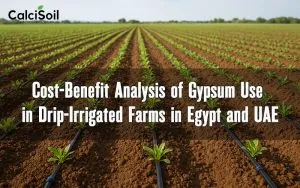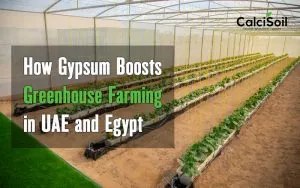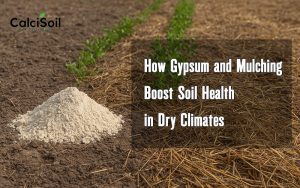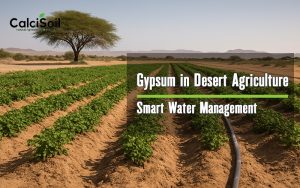
Agricultural sulfur is an essential nutrient for plant growth and development. It is one of the 17 essential plant nutrients and is required by all crops, without exception. Sulfur is necessary for protein synthesis and is needed for the vital needs of plants throughout their cycle. including for building up seed reserves. Sulfur is not mobile in the plant, so a continuous supply of sulfur is needed from emergence to crop maturity.
A deficiency of sulfur at any stage of growth can result in reduced yields. Canola and alfalfa are examples of high sulfur-using crops. Sulfur deficiency symptoms resemble nitrogen deficiency, with leaves becoming pale-yellow or light green. Unlike nitrogen, sulfur-deficiency symptoms appear first on the younger leaves and persist even after nitrogen application. Generally speaking, soils today receive seven times less sulfur than they did 30 years ago.
gypsum and agricultural sulfur differences
Gypsum and other nutrients like agricultural sulfur are both used as soil amendments, but they have different properties and functions. Here are the main differences between the two.
Chemical composition: Gypsum is a hydrated form of calcium sulfate (CaSO4) and is neutral in pH. It consists of 29.4% calcium and 23.5% sulfur. On the other hand, agricultural sulfur can be in the form of elemental sulfur (S) or sulfate sulfur. (e.g., gypsum or ammonium sulfate).
pH: Applying gypsum to the soil will raise the calcium and sulfur levels but will not raise the pH. In contrast, elemental sulfur is more mobile in the soil and can be oxidized to sulfate prior to plant uptake. which can affect the soil’s pH.
Solubility: Gypsum is more soluble than most lime products and can provide a source of soluble calcium and sulfate. Elemental sulfur is less soluble and does not readily leach like sulfate forms.
Soil improvement: Gypsum can help improve soil structure, water infiltration, and nutrient availability. It can be particularly beneficial for crops like corn, soybean, canola, and alfalfa. Elemental sulfur, on the other hand, is commonly used in fall applications to supply sulfur to crops.
Application: Gypsum is typically applied before planting in the spring. Elemental sulfur can be applied at the same time as gypsum or separately. depending on the specific needs of the crop and soil conditions.
In summary, gypsum and agricultural sulfur have different chemical compositions, solubilities, and functions in soil. Gypsum is a more soluble and readily available source of calcium and sulfate. while agricultural sulfur can be in various forms, including elemental and sulfate sulfur. The choice between the two depends on the specific needs of the crop, soil conditions, and the desired outcome.
Gypsum or agricultural sulfur
Gypsum is a valuable source of sulfur for plant nutrition in agriculture. It is an excellent source of both calcium and sulfur, which are essential for plant growth and crop yield. Gypsum can provide a continual release of sulfur to the soil for more than just the year it is applied. benefiting crops such as corn, soybean, canola, and alfalfa. Additionally, it helps improve soil structure, water infiltration, and reduces runoff and erosion. Therefore, gypsum does replace agricultural sulfur by providing an important source of sulfur for plant nutrition.
However when comparing gypsum to other sources of sulfur, it’s essential to consider the specific needs of crops and soil. Gypsum is a neutral pH amendment that provides both calcium and sulfur. making it an excellent choice for soils with a pH imbalance or deficiencies in calcium.
Time to use gypsum instead of agricultural sulfur
Gypsum should be used instead of agricultural sulfur when a soil needs both calcium and sulfur. but the pH is already at an adequate level. Gypsum is a neutral salt that supplies the crop-available form of calcium and sulfur without affecting the soil pH. It is a good source of both calcium and sulfur, benefiting various crops and improving soil structure and water absorption.
Additionally, the sulfate in gypsum provides quicker release of sulfur than elemental sulfur, making it a practical choice for farmers. On the other hand, agricultural sulfur, particularly elemental sulfur, needs to be oxidized to sulfate before plant uptake. and it is commonly used when a soil requires a more long-term sulfur supply.
The downsides to using gypsum instead of agricultural sulfur
The downsides to using gypsum instead of agricultural sulfur include these.
Slower Release: While the sulfate in gypsum provides a quicker release of sulfur than elemental sulfur, it is not as soluble as some other forms of sulfur, such as ammonium sulfate, providing a slower release after the initial boost.
Limited Solubility: Gypsum is not as soluble as some other forms of sulfur, which may affect its availability to plants in the short term.
Calcium Content: Gypsum is high in calcium, which may not be needed in soils with sufficient calcium levels, potentially leading to an excess of calcium in the soil.
These factors should be considered when deciding between gypsum and agricultural sulfur for soil amendment and crop production.







